Owning an RV opens the door to endless adventures, but figuring out where to store your RV after purchasing it is just as important. Proper storage ensures your investment stays in great shape, so let’s explore your options. Discover the best options for storing your RV after purchase. Learn where to put your RV—at home, storage facilities, or campgrounds—and find tips for safe and secure storage. where to put my rv after I buy it ?
RV Storage Options: Keeping Your RV Safe and Secure
After buying an RV, storage can be a challenge if you don’t have enough space at home. Thankfully, several excellent options are available to protect your vehicle.
Storing Your RV at Home
Home storage is convenient and cost-effective:
- Driveway Parking: Perfect if you have space. Ensure local ordinances allow RV parking.
- Garage Storage: Ideal for smaller RVs, like camper vans or travel trailers.
- Backyard Space: Create a dedicated area with a protective cover or RV canopy.
Renting an RV Storage Facility
If home storage isn’t an option, RV storage facilities offer secure alternatives:
- Outdoor Storage Lots: Affordable and spacious, but ensure your RV is covered.
- Indoor Storage Units: More expensive but provide excellent protection from weather and theft.
- Covered Parking Spaces: A middle-ground option offering partial weather protection.
Seasonal Campground Storage
Many campgrounds allow long-term RV storage. This option is great if you frequently camp in the same area:
- Affordable Rates: Seasonal contracts can save money.
- Convenient Access: Your RV is already near your favorite camping spots.
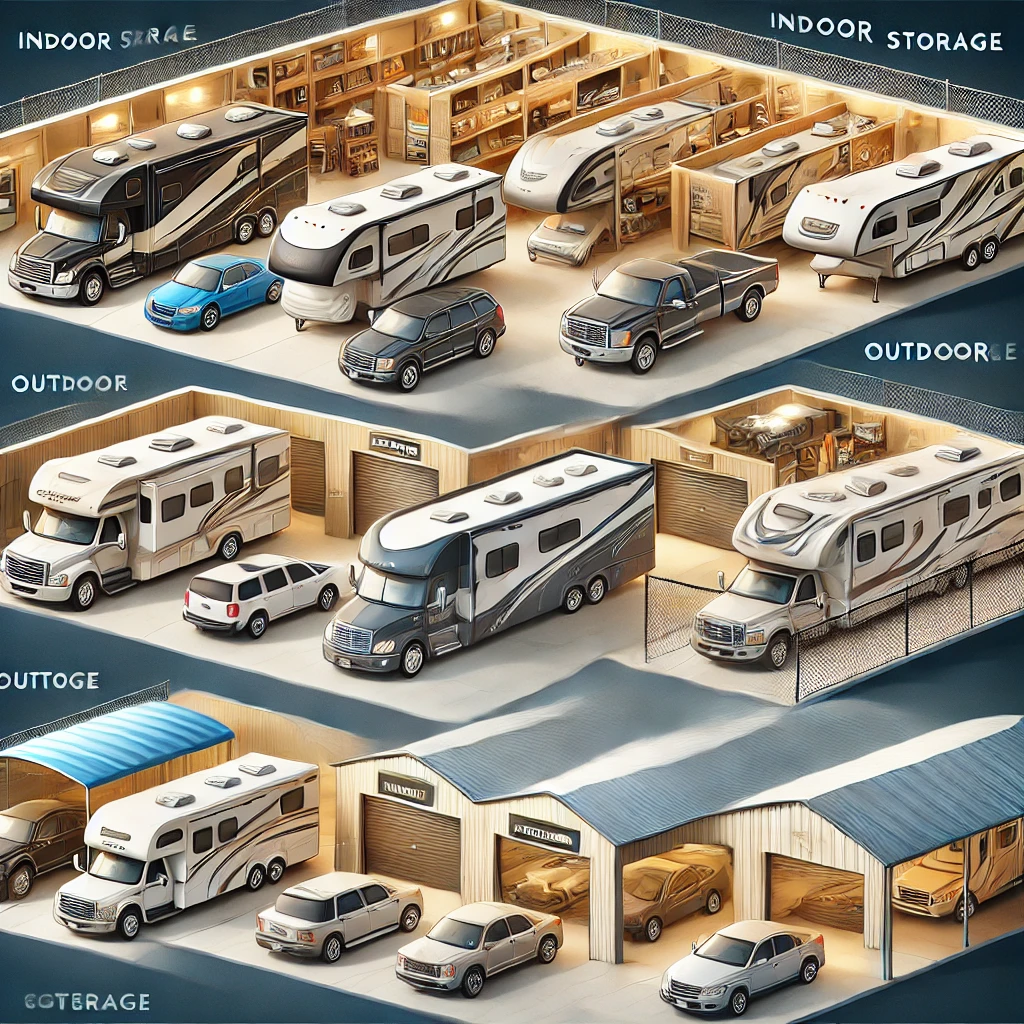
Considerations Before Choosing an RV Storage Option
Always think about these factors before deciding:
- Weather Conditions: Extreme heat, cold, or humidity can damage your RV.
- Security Features: Opt for storage options with surveillance and restricted access.
- Accessibility: Ensure you can access your RV whenever you need it.
- Budget: Match your storage choice to your budget while ensuring adequate protection.
Protecting Your RV During Storage
No matter where you store your RV, these tips can extend its lifespan:
- Use an RV Cover: Shield it from dirt, debris, and UV rays.
- Maintain Proper Ventilation: Prevent mold and mildew.
- Check Regularly: Inspect your RV periodically for pests or wear and tear.
Why There Is a Need to Store an RV
Storing an RV properly is essential to protect your investment and ensure it’s ready for future adventures. Whether you’re a full-time RVer or a seasonal traveler, understanding the importance of RV storage can save you money and prevent unnecessary damage.
Protecting Your RV From Weather Damage
Exposure to the elements is one of the biggest threats to your RV. Proper storage shields your RV from:
- UV Rays: Prolonged sun exposure can cause fading, cracking, and roof damage.
- Rain and Snow: Moisture can lead to leaks, rust, and mold.
- Extreme Temperatures: Both hot and cold climates can impact your RV’s tires, seals, and interior.
Preventing Wear and Tear
When an RV sits unused, it can suffer from natural wear and tear. Storing your RV properly helps avoid:
- Tire Deterioration: Protects against flat spots and cracking.
- Battery Drain: Disconnecting or maintaining the battery during storage ensures longevity.
- Pest Infestations: Covered storage minimizes the risk of rodents and insects damaging your RV.
Saving Money on Repairs and Maintenance
Neglecting RV storage can result in costly repairs:
- Roof Repairs: Uncovered RVs are prone to leaks that damage the roof and interior.
- Paint and Decal Restoration: Weather exposure can fade the exterior, requiring expensive fixes.
- Electrical System Issues: Proper storage prevents corrosion and short circuits in your RV’s wiring.
Maintaining Resale Value
If you plan to upgrade or sell your RV in the future, proper storage is key to preserving its resale value. Buyers are more likely to pay top dollar for a well-maintained RV without visible signs of neglect.
Enhancing Convenience and Longevity
When your RV is stored properly:
- You’re Ready for Adventures: A well-maintained RV means fewer pre-trip preparations.
- You Extend Its Lifespan: Protecting your RV from avoidable damage ensures it lasts longer.
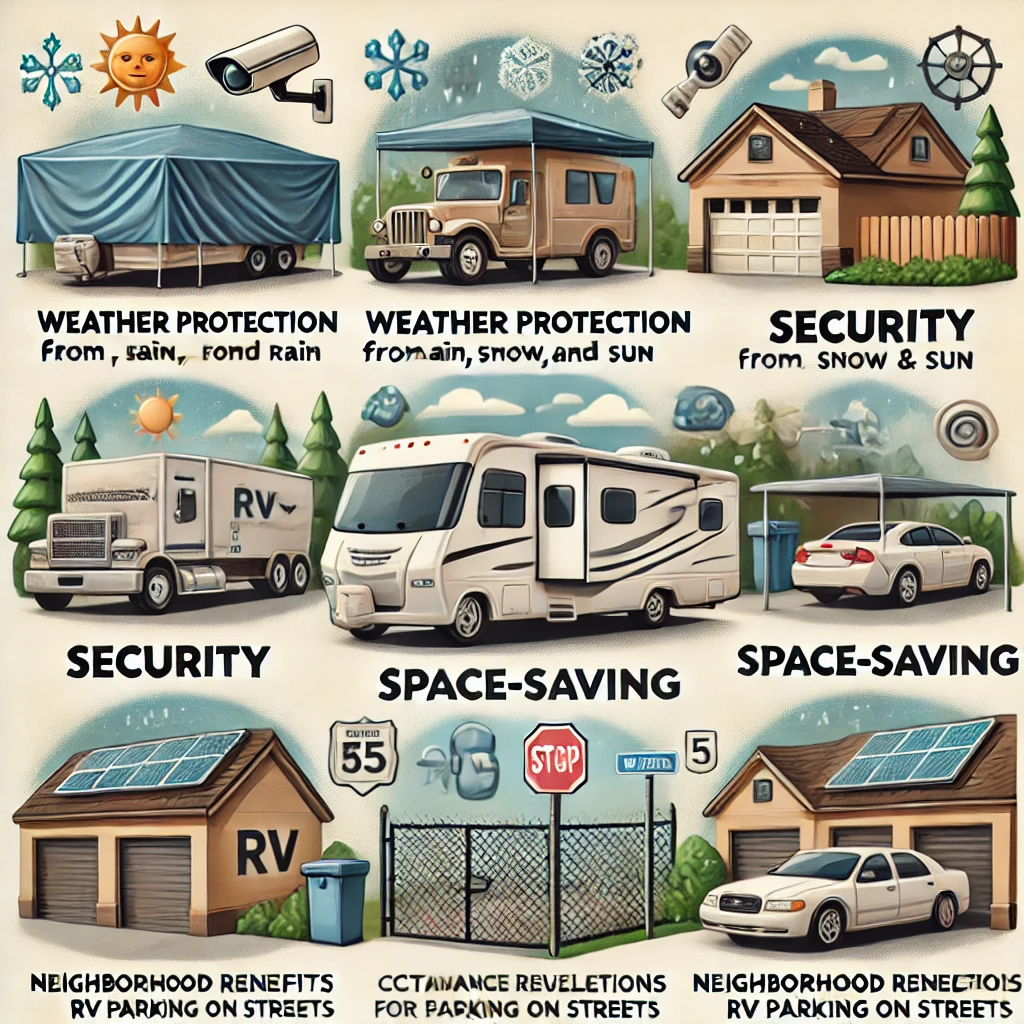
Laws and Regulations for Storing RVs
Storing an RV isn’t just about finding the right spot—it’s also about complying with local laws and regulations. Many areas have specific rules governing RV storage to ensure safety, aesthetics, and community standards. Understanding these laws can help you avoid fines or disputes.
Zoning and HOA Regulations for RV Storage
Before storing your RV, it’s essential to check local zoning laws and Homeowners Association (HOA) rules:
- Residential Zoning Laws: Some neighborhoods restrict RV storage in driveways or visible areas.
- HOA Rules: Homeowners Associations often have strict guidelines about RV storage, such as requiring them to be out of sight or stored in garages.
- Permit Requirements: Certain areas may require a permit for long-term RV parking at home.
Parking Restrictions on Public Property
Storing your RV on public property can be tricky due to local parking ordinances:
- Street Parking Limits: Many cities restrict the size, weight, and duration an RV can be parked on public streets.
- Seasonal Rules: Snow removal or other seasonal concerns may limit RV street parking during specific times of the year.
- Fines for Violations: Ignoring these regulations can lead to fines or even towing.
State-Specific RV Storage Regulations
Each state has unique laws about RV storage. Here are some common considerations:
- Weight and Size Restrictions: States may limit the maximum dimensions of RVs stored on residential properties.
- Environmental Requirements: Proper waste disposal systems are often mandated to prevent contamination.
- Proximity to Property Lines: Some states require RVs to be stored a certain distance away from neighbors or property boundaries.
Environmental and Fire Safety Regulations
To ensure safety and compliance, you may need to follow additional requirements:
- Fuel and Battery Storage: Many areas require RVs to be drained of fuel or disconnected from batteries while in storage.
- Fire Codes: Local fire departments may have rules about storing RVs near flammable materials or structures.
- Pest Control Measures: Regulations may mandate preventive measures to avoid pest infestations.
Best Practices to Stay Compliant
Here are some tips to help you follow RV storage laws and regulations:
- Check Local Codes: Consult your city or county’s website for zoning and parking regulations.
- Talk to Your HOA: Review your HOA’s bylaws for any RV-related restrictions.
- Use Designated Storage Facilities: These facilities are often exempt from residential storage rules.
- Maintain Proper Licensing: Keep your RV registration and tags up to date to avoid violations.
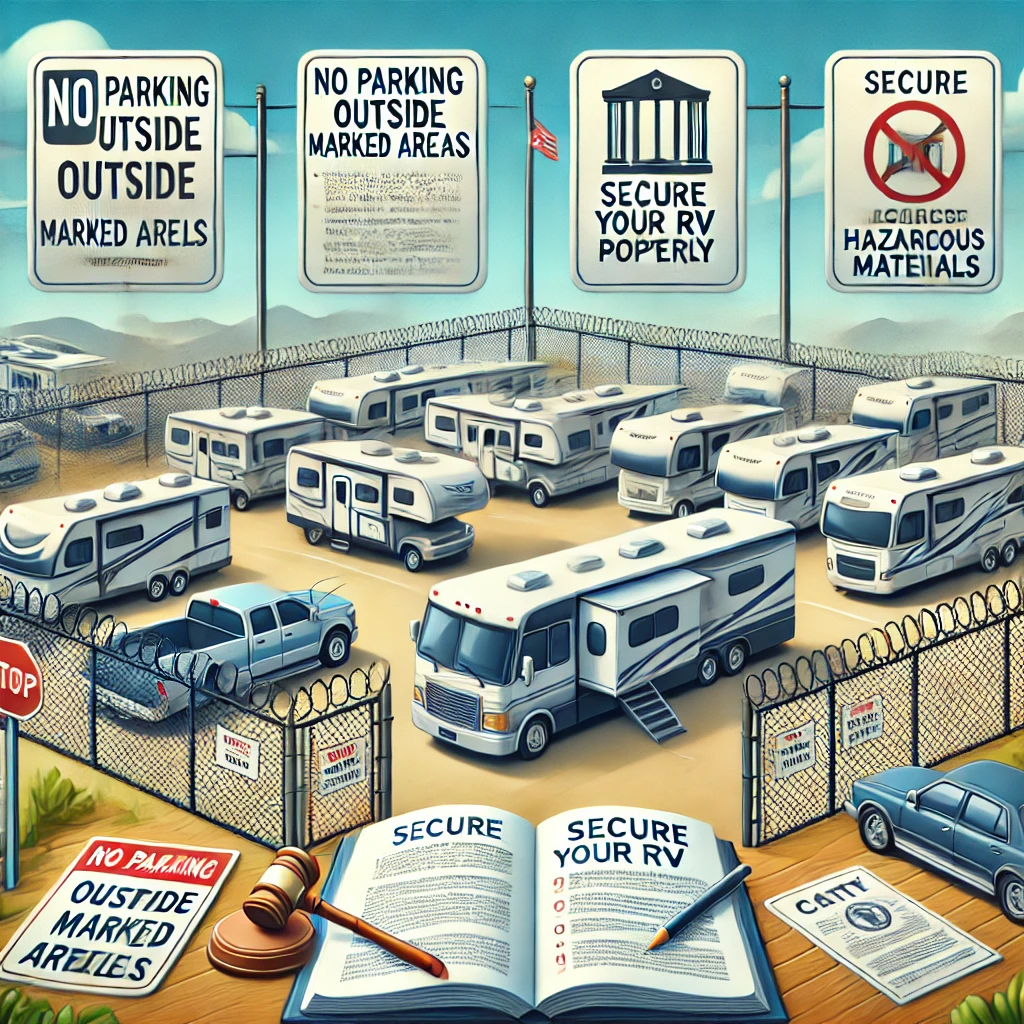
How to Store Different Classes of RV
Storing your RV properly depends on its class, size, and unique features. Each class—A, B, C, or towable RVs—requires specific storage methods to ensure it stays in excellent condition. Proper storage not only protects your investment but also keeps your RV ready for your next adventure.
Storing Class A Motorhomes
Class A motorhomes are large and luxurious, requiring extra care during storage.
Key Considerations for Class A RVs
- Size Accommodation: Choose a storage space large enough for the height and length of your RV.
- Climate-Controlled Storage: Opt for indoor storage in extreme climates to protect against temperature fluctuations.
- Protect the Roof: Use an RV cover to shield the roof from sun damage and leaks.
Maintenance Tips for Class A Storage
- Drain water tanks to prevent freezing.
- Disconnect the battery to avoid drainage.
- Check tire pressure regularly during long-term storage.
Storing Class B Camper Vans
Class B RVs are more compact, making storage slightly easier.
Storage Options for Class B Camper Vans
- Garage Parking: Most Class B RVs can fit in residential garages.
- Outdoor Lots: Use a high-quality RV cover for protection if stored outside.
Preventative Measures for Class B Vans
- Ventilate the interior to prevent mold and mildew.
- Close windows and doors tightly to keep pests out.
Storing Class C Motorhomes
Class C RVs fall between Class A and Class B in size and complexity.
Storage Tips for Class C RVs
- Covered Storage: Prevent sun and weather exposure with a carport or canopy.
- Wheel Stabilizers: Use chocks or stabilizers to prevent tire damage during storage.
Maintenance Checklist for Class C Storage
- Remove perishable items and clean the interior.
- Check the roof seals and reseal if needed.
Storing Towable RVs (Travel Trailers, Fifth Wheels, and Pop-Ups)
Towable RVs have unique storage needs due to their detachment from a motorized vehicle.
Storing Travel Trailers and Fifth Wheels
- Unhitch the Trailer: Use jacks to support the frame and reduce pressure on tires.
- Protect the Hitch: Apply grease and cover the hitch to prevent rust.
Storing Pop-Up Campers
- Fully Collapse: Ensure the camper is folded down and secured to avoid water pooling.
- Use a Waterproof Cover: Protect the soft sides from moisture and pests.
General RV Storage Tips for All Classes
No matter the class of RV, these practices apply:
- Clean Thoroughly: Remove dirt, debris, and food to prevent pests.
- Empty Water Tanks: Drain tanks and add antifreeze if storing during winter.
- Disconnect Power Sources: Avoid battery drainage by unplugging appliances.
- Cover and Lock: Use an RV cover and secure all entry points to deter theft and damage.
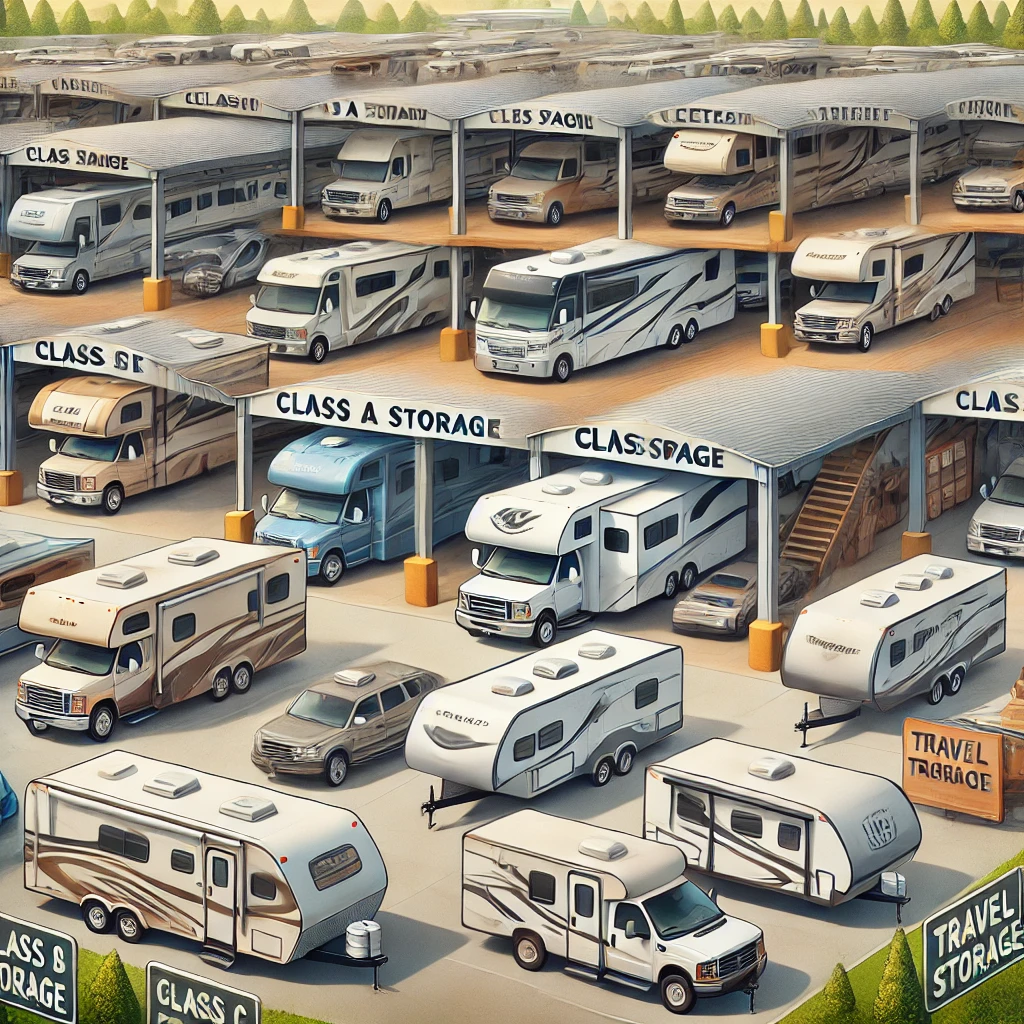
Maintenance and Safety Measures Before Storing an RV
Preparing your RV for storage is crucial to maintaining its condition and ensuring it’s ready for your next adventure. Neglecting proper maintenance and safety measures can lead to costly repairs and preventable damage. Follow these steps to store your RV safely and effectively.
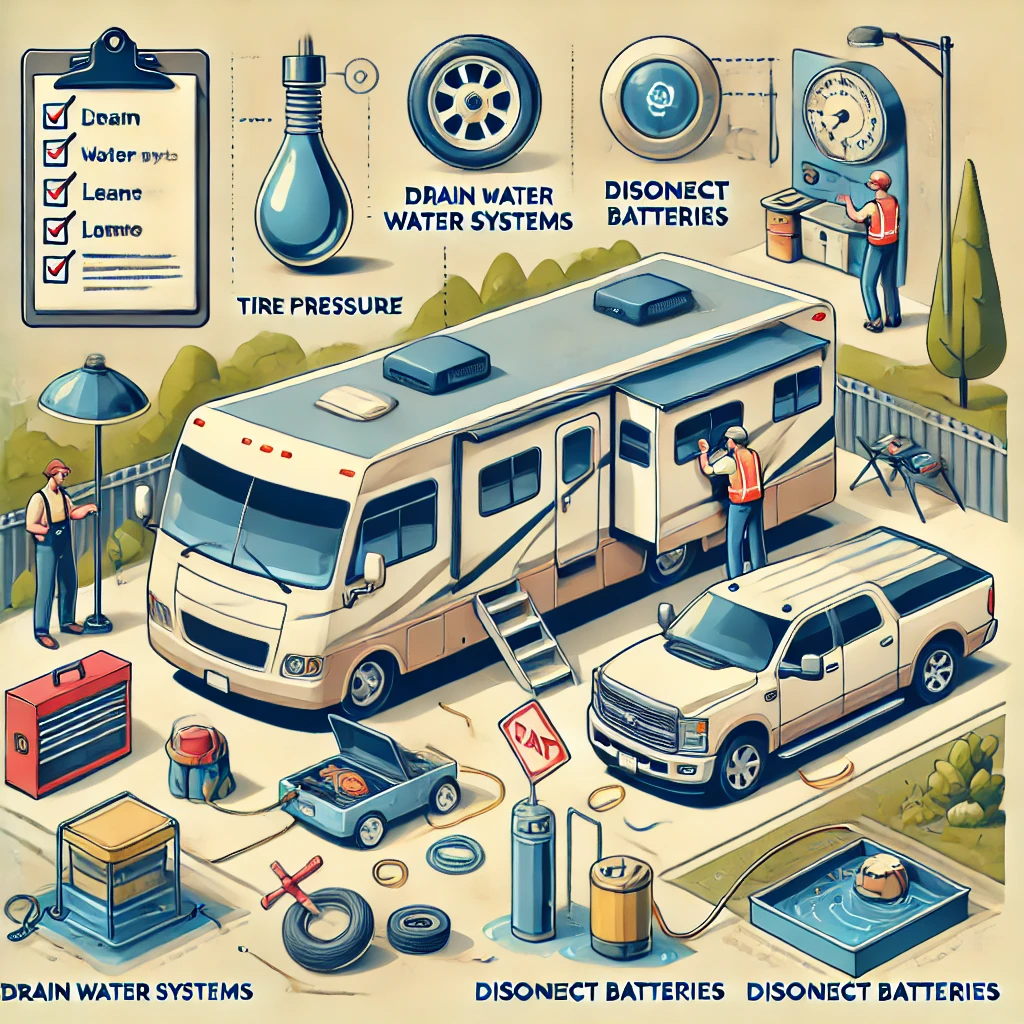
Essential Maintenance Before Storing an RV
Clean and Inspect the RV
- Exterior Cleaning: Wash and wax the exterior to remove dirt, grime, and road salt. Waxing adds a protective layer against the elements.
- Interior Cleaning: Vacuum, wipe surfaces, and remove all food to prevent pest infestations.
- Inspect for Damage: Check for cracks, leaks, or loose seals on windows, doors, and the roof. Repair any damage before storage.
Drain and Winterize Water Systems
- Empty All Tanks: Drain fresh, gray, and black water tanks completely.
- Winterize Water Lines: Add RV antifreeze to the plumbing system if storing in freezing temperatures.
Protecting RV Systems During Storage
Electrical System Maintenance
- Disconnect the Battery: Remove the battery and store it in a cool, dry place. Charge it periodically to maintain its life.
- Turn Off Appliances: Ensure all electrical devices and appliances are switched off.
Tire Care
- Inflate Tires: Check tire pressure and inflate to the manufacturer’s recommended PSI.
- Use Tire Covers: Protect tires from UV rays and weather exposure.
- Avoid Flat Spots: Move the RV slightly or use jack stands to prevent tire damage.
Safety Measures to Prevent Long-Term Damage
Seal and Protect Openings
- Cover Vents and Windows: Use vent covers and window shades to block sunlight and moisture.
- Check Entry Points: Seal all gaps and holes to prevent pests from entering.
Use an RV Cover
- Waterproof Cover: Invest in a high-quality, breathable RV cover to protect against weather, UV rays, and debris.
- Roof Protection: Ensure the cover fits snugly to avoid water pooling on the roof.
Stabilize and Secure the RV
- Stabilizing Jacks: Use stabilizers to keep the RV level and reduce stress on the frame.
- Lock Doors and Compartments: Secure all entry points to deter theft and vandalism.
Regular Maintenance During Storage
- Inspect Periodically: Check the RV every few weeks for leaks, pests, or other issues.
- Ventilation: Open vents slightly to maintain airflow and prevent moisture buildup.
- Check Batteries and Tires: Ensure batteries are charged and tires are in good condition.
Common RV Storage Mistakes and Their Solutions
Storing your RV properly is vital for its longevity and functionality, but mistakes during this process can lead to costly repairs and damage. By identifying these common storage errors and learning their solutions, you can keep your RV in excellent condition.
Skipping Cleaning Before Storage
Problem:
Dirt, grime, and leftover food attract pests and cause stains or mold growth.
Solution:
- Clean Thoroughly: Wash the exterior, vacuum the interior, and wipe down surfaces.
- Empty Food Storage: Remove all perishables and clean out cabinets and the refrigerator.
Neglecting Water System Maintenance
Problem:
Failing to drain water systems can lead to frozen pipes, mold, or unpleasant odors.
Solution:
- Drain and Winterize: Empty all water tanks and lines. Add RV antifreeze to plumbing if storing in cold climates.
- Flush Tanks: Clean black and gray water tanks with tank-specific cleaners before storage.
Ignoring Battery Maintenance
Problem:
Leaving the battery connected can drain its charge, leading to permanent damage.
Solution:
- Disconnect the Battery: Remove and store it in a cool, dry place.
- Periodic Charging: Use a trickle charger to maintain the battery’s health during storage.
Failing to Protect Against Pests
Problem:
Openings in the RV invite rodents and insects, which can cause extensive damage.
Solution:
- Seal Openings: Check and seal gaps, vents, and windows.
- Use Pest Deterrents: Place mothballs, traps, or natural repellents inside the RV.
Leaving Tires Unattended
Problem:
Tires can develop flat spots or cracks when left stationary for long periods.
Solution:
- Inflate Tires: Maintain proper tire pressure as recommended by the manufacturer.
- Use Tire Covers: Protect tires from UV rays and weather exposure.
- Relieve Pressure: Use jack stands or move the RV slightly every few weeks.
Using the Wrong Cover
Problem:
Improper covers can trap moisture, leading to mold and mildew.
Solution:
- Choose a Breathable RV Cover: Invest in a cover designed specifically for RVs to prevent condensation.
- Ensure Proper Fit: A snug fit prevents water pooling or flapping in the wind.
Overlooking Security Measures
Problem:
Leaving the RV unsecured increases the risk of theft or vandalism.
Solution:
- Lock All Entry Points: Secure doors, windows, and storage compartments.
- Install Security Devices: Use wheel locks, alarms, or GPS trackers for added protection.
Forgetting Periodic Inspections
Problem:
Issues like leaks, pests, or low battery charge can go unnoticed over months of storage.
Solution:
- Regular Inspections: Check your RV every few weeks for signs of damage or pests.
- Ventilation: Open vents slightly to maintain airflow and prevent moisture buildup.
Conclusion
Avoiding common RV storage mistakes ensures your vehicle remains in great shape for your next adventure. By cleaning, sealing, and maintaining your RV properly, you can prevent damage, save money, and extend the life of your vehicle. Proper preparation and regular checks are the keys to hassle-free RV storage.
More info will be available on Flamingo Motorhomes.

